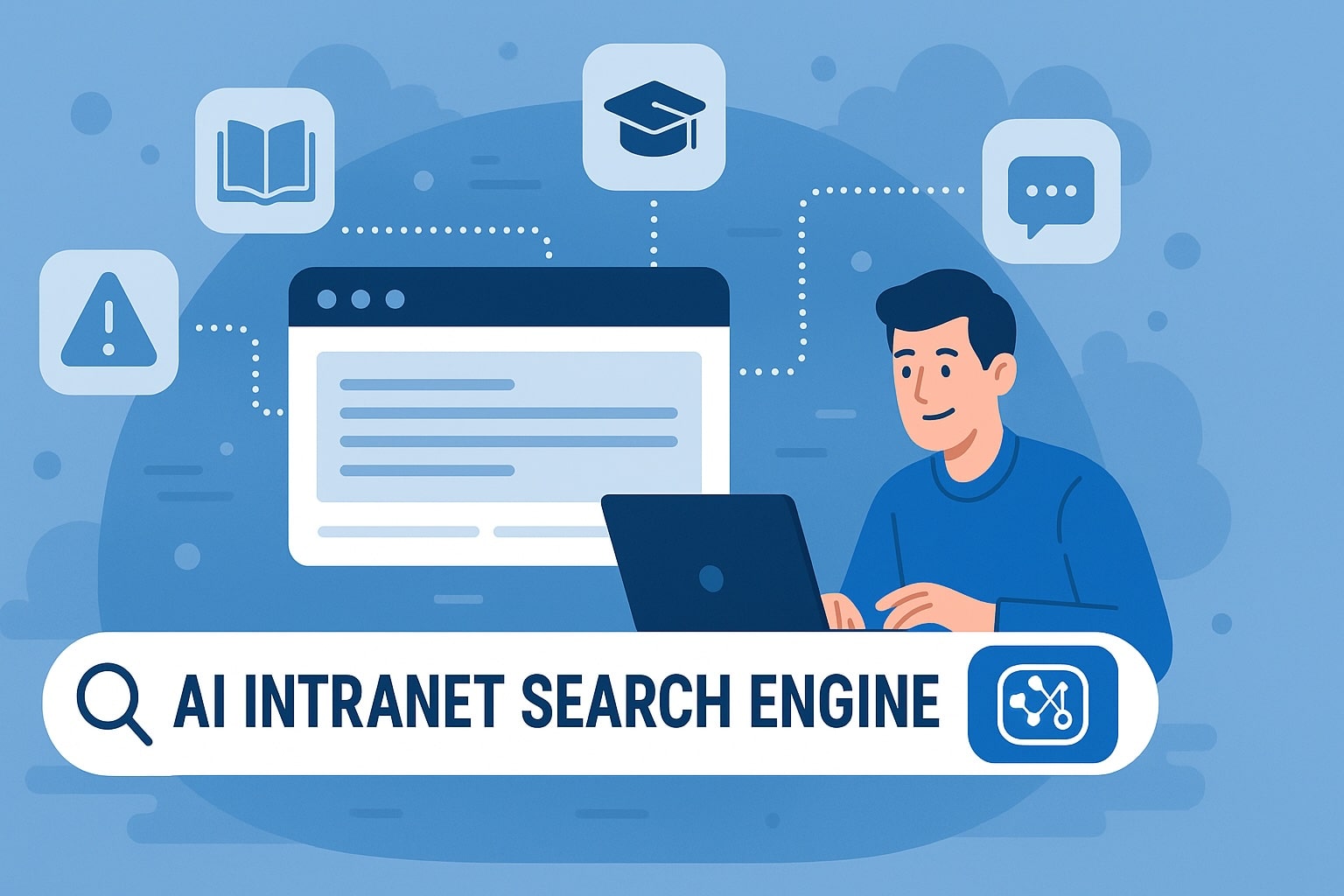Modern workplaces thrive on speed and easy access to knowledge. This article explores why intranet search has become mission-critical, how it works, and what AI brings to the table. You’ll learn the benefits of intranet search, key technologies behind it, how to evaluate the right platform, and best practices to implement search across your organization. We’ll also show how HubEngage takes intranet search further by connecting other company systems and delivering actionable answers.
What Is an Intranet Search Engine and Why It Matters?
Employees spend 2.5 hours every day just searching for information (McKinsey). That’s wasted time, lost productivity, and frustrated employees. An intranet search engine solves this by turning your company intranet into a powerful discovery hub. Instead of clicking through endless menus or outdated folder structures, employees simply search first—just like they do on Google.
A modern search engine for intranet does more than keyword lookups. It uses semantic understanding and AI to surface the right answers instantly. With solutions like HubEngage’s AI intranet search, employees not only get summaries but also actionable next steps—for example:
- Searching for “leave policy” → get a clear summary, plus links to apply for leave or check balance.
- Asking “new hire training” → see the policy, plus quick access to the LMS course.
This shift from browsing to search-first engagement is why intranet search has become a non-negotiable feature of every modern intranet software platform.
Key Benefits of a Great Intranet Search Engine
A well-designed internal search engine for companies delivers measurable business value:
- Productivity Gains – Quick access to documents, policies, and updates saves hours per employee per week.
- Employee Experience – Employees feel empowered, not frustrated, when they can find what they need in seconds.
- Governance & Compliance – Ensures employees rely on the most up-to-date policies and avoid shadow sources.
- Cross-System Discovery – Modern intranet search doesn’t stop at intranet content. With HubEngage, you can also connect data sources like Google Drive, OneDrive, SharePoint, LMS, and corporate websites.
- Content Gap Insights – Analytics reveal not only what people search for but also when queries go unanswered—helping you identify knowledge gaps and fill them proactively.
👉 For organizations evaluating platforms, check out top intranet software platforms with search capabilities.
How Intranet Search Works & Core Technology
At its foundation, an intranet search engine relies on three core layers:
- Federated Search
- Connects and indexes content across intranet pages, wikis, chat tools, file storage, and external knowledge bases.
- Example: Employees search once, and results appear from the intranet, LMS, and shared drives.
- Indexing & Relevancy Ranking
- Crawlers and APIs gather metadata, tags, and full-text content.
- Relevance algorithms prioritize results by freshness, user role, and engagement history.
- Search UI & UX
- Autocomplete, filters, and personalization ensure employees get accurate results with minimal effort.
- Integration into mobile apps and digital signage means search is always accessible.
(Reference: Meilisearch overview, Unily’s enterprise guide)
AI in Intranet Search: NLP, RAG & Personalization
Traditional keyword search has limits. Employees expect Google-like intelligence inside the workplace. This is where AI intranet search comes in.
Key Capabilities:
- Natural Language Processing (NLP): Understands intent beyond keywords. A query like “maternity leave steps” is matched to policy docs, HR guides, and forms.
- Retrieval-Augmented Generation (RAG): Summarizes long documents into concise, AI-powered overviews.
- Personalization: Results adapt to the user’s role, location, and past activity. A store manager sees frontline updates first; an HR manager sees compliance updates first.
- Actionable Search: Unlike most competitors, HubEngage goes beyond answers to offer next steps—apply for leave, register for training, update personal info.
- Search Analytics: Companies know not only what employees search for, but also whether the AI was able to answer. This allows continuous improvement of intranet content.
Competitors like Glean and ClickUp highlight federated AI search, but HubEngage takes it further by combining semantic, generative AI, and workflow actions in one experience. Learn more about AI intranet features.
Going Beyond Intranet – Connecting Other Company Systems
Modern AI intranet search engines aren’t limited to intranet pages—they become a central discovery layer for all company systems. With platforms like HubEngage, employees can search across:
- Learning Management Systems (LMS): Access training modules and course details.
- Safety & Compliance Sites: Instantly pull up safety protocols and compliance checklists.
- Knowledge Bases & Wikis: Surface troubleshooting guides or department FAQs.
- Cloud Storage (Google Drive, OneDrive, SharePoint): Bring together documents scattered across multiple platforms.
Even better, the search experience isn’t tied only to the intranet. HubEngage search can also work as a standalone engine or be embedded in other employee tools, including:
- Microsoft Teams or Slack apps
- WhatsApp or SMS bots
- Mobile employee apps
This means employees can simply ask a question—“What’s the travel reimbursement policy?”—directly in Teams, Slack, or even text messaging, and get a summarized answer with next-step actions. By breaking the boundaries of the intranet, AI search becomes a true company-wide knowledge companion.
👉 Learn more about the HubEngage AI Chatbot.
Selection Criteria: Choosing the Right Intranet Search
When evaluating a search engine for intranet, consider:
- Speed & Accuracy – Instant results with AI-driven relevance.
- Federated Search Capabilities – One query surfaces results across all enterprise systems.
- Security & Compliance – Permissions respected, sensitive data protected.
- User Experience – Simple, intuitive, mobile-first design.
- Admin Analytics – Insights into unanswered queries and trending searches.
- AI Capabilities – Summarization, personalization, and next-step actions.
(Corexta emphasizes evaluation based on UX + governance + speed, while Unily underscores personalization as the differentiator.)
👉 For more insights, see how a quick intranet search for communication improves productivity.
Implement and Optimize Your Intranet Search: Best Practices
Implementation goes beyond turning search on—it’s about continuous tuning.
- Index Everything That Matters – Policies, procedures, training, HR forms, chat histories, and external knowledge bases.
- Refine Taxonomy & Metadata – Use consistent tagging and naming conventions.
- Monitor Logs & Analytics – Identify “zero result” queries and add missing content.
- Mobile Optimization – Ensure search works seamlessly on mobile intranet apps.
- Feedback Loop – Encourage employees to rate search results and provide feedback.
Internal vs Traditional Search: Use-Case Comparison
| Feature | Intranet Search Engine | Traditional Web Search |
|---|---|---|
| Scope | Internal, secure company data | Public web |
| Permissions | Respects employee roles and access | No role-based access |
| AI Context | Personalized to company policies, workflows, next steps | General answers, not company-specific |
| Insights | Tracks employee queries and content gaps | No visibility into internal needs |
| Integration | Federates across LMS, HRIS, drives | Limited to public sources |
In short, Google is for the world. Intranet search is for your company.
Conclusion: Why HubEngage Leads in Intranet Search
An intranet without effective search is just another static website. A modern intranet search engine—especially one powered by AI, NLP, and federated integrations—unlocks productivity, engagement, and employee satisfaction.
HubEngage’s AI intranet search engine combines traditional semantic discovery with AI summaries and next-step actions, ensuring employees not only find answers but can act on them. With federated integrations across Google Drive, OneDrive, LMS, and more, HubEngage provides the most comprehensive intranet search experience available today.
👉 Ready to see it in action? Explore HubEngage intranet solution and Sign up for a demo.
Frequently Asked Questions
What is an intranet search engine?
An intranet search engine is a tool that lets employees quickly find documents, policies, and resources across a company’s internal systems.
How does AI improve intranet search?
AI enhances search by understanding natural language, summarizing results, personalizing answers, and offering actionable next steps.
Can an intranet search connect to external sources?
Yes. Platforms like HubEngage support federated search, pulling answers from intranets, LMS, Google Drive, OneDrive, SharePoint, and more.
What’s the difference between intranet search and Google search?
Google searches the public web. Intranet search is internal, secure, role-based, and tailored to company-specific content.













